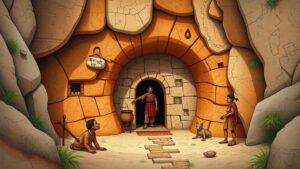Searching for the “Shrine of Forgotten Names,” where inscriptions reveal lost lineages.
Searching for the “Shrine of Forgotten Names”: Unveiling Lost Lineages
Throughout history, countless cultures have left behind legacies inscribed in stone, whispering tales of lost lineages and forgotten stories. One such enchanting artifact is the “Shrine of Forgotten Names,” a fictional or metaphorical representation of the many ways we honor our ancestry. This article dives into the quest for understanding these lost memories, particularly the significance of inscriptions in tracing historical narratives.
The Historical Context of Lineage and Inscription
Inscription practices date back millennia. Ancient civilizations, such as the Egyptians and Mesopotamians, utilized inscriptions to document their history and honor their ancestors. For example, Egyptians carved hieroglyphics on tomb walls, outlining the achievements and lineages of their pharaohs. This practice reflected a broader cultural reverence for family and lineage, an idea that continues in various forms today.
Inscriptions serve as tangible links connecting current generations with the past. act as historical records, similarly to how a family tree traces lineage through names and relationships. Each name inscribed can reveal details about heritage, ethnicity, and even social status.
Discovering the Shrine of Forgotten Names
The notion of the Shrine of Forgotten Names invites exploration into real-world locations rich with history. While there may not be a singular destination known by this name, various sites worldwide symbolize the concept of forgotten lineages:
- The Tomb of the Unknown Soldier: Found in Arlington, Virginia, this memorial honors unidentified soldiers, representing the vast number of individuals whose stories are forever lost.
- The National World War I Memorial: In Kansas City, Missouri, this site commemorates over 116,000 American soldiers, many of whom are missing from historical accounts, akin to a “shrine” for lost names.
- Family Clans and Clan Stones in Scotland: Many family clans have specific stones inscribed with their lineage history, representing lost names and traditional ancestral lines.
The Importance of Inscriptions in Genealogy
The study of genealogy has surged in popularity, driven by available information and technological advances. Inscriptions play a vital role in genealogy, aiding researchers in tracing familial connections. A 2019 survey by the Pew Research Center noted that 44% of U.S. adults expressed interest in researching their family tree.
Key sources for inscriptions include:
- Cemeteries: Many gravestones have birth and death dates, familial ties, and even brief inscriptions that contribute significantly to lineage research.
- Church Records: Birth, marriage, and death records often include names essential for constructing family trees.
- Historical Documents: Tax records, land deeds, and wills frequently contain names and relationships that contribute to our understanding of family histories.
The Role of Technology in Uncovering Lost Lineages
Modern advancements in technology have transformed genealogy research. Tools like Ancestry.com, MyHeritage, and FamilySearch allow users to sift through vast databases of historical records, many containing inscriptions. A specific development is DB (Database of Biographical Names), which aggregates names and lineages from various sources for easier access.
Also, DNA testing services such as 23andMe and AncestryDNA provide insights into genetic backgrounds, further connecting individuals with their lost ancestors. These tools not only empower individuals to discover their roots but also unite families that may have been divided over generations.
Conclusion: The Ongoing Quest for Lost Lineages
The “Shrine of Forgotten Names,” though more a conceptual haven, represents the broader human desire to connect with our past. Through inscriptions, genealogical research, and technology, we can increasingly uncover the stories of those who came before us. The journey of discovering lost lineages not only enriches our understanding of history but also reinforces our familial bonds.
In our quest to honor these forgotten names, we must continue to document stories, share knowledge, and celebrate the legacies of our ancestors. Each inscription, be it in stone or digital format, adds a layer to our collective narrative, ensuring that no lineage is truly forgotten.



